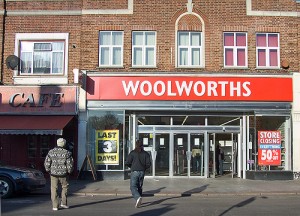Last week I went to a fascinating discussion hosted by ThinkSpace, a new innovation hub run by Imperial College London. The subject of the discussion was what they termed iConsumerism: how digital innovations, e-commerce and ‘always online’ are changing consumer behaviour, and the consequences of this for the traditional high street. It was good discussion, and I’ll update this post with a video of the full talk when it becomes available, but for the time being I’ll do my best to summarise the main thrust.

Whilst ostensibly the evening was to discuss consumer behaviour in the digital age, it quickly turned into a mediation on the “demise of the high street”. The past few years have seen quite a few stalwarts of the British high street (HMV, Jessops, Comet, Woolworths, to name but a few) go to the wall. The trend is highly likely to continue, with the Centre for Retail Research predicting that the number of high street shops will decline by a further 22% by 2018. The Daily Mail, ever the wallflower, declared “High Street Armageddon”.
iConsumerism and retail decline
The decline of the bricks and mortar retail stores is a complex phenomenon, but there are two main trends. The recession that has laid low the UK and much of the western world since 2008 has certainly had an influence, and is the catalyst that pushed many of these brands over the edge. The root cause of the problem though is, as ever, changing consumer behaviour. E-commerce (Amazon), and the replacement of some physical goods with digital equivalents (iTunes, Netflix), have changed where people shop and what they buy. When people do go to the high street now, it’s often just to browse products and then buy them cheaper online (known as ‘showrooming’). It’s been estimated that in 2012 24% of British shoppers did this whilst Christmas shopping, with 40% of those buying from elsewhere as a result. One of the panellists described how staff at the now defunct Comet once ejected him for taking a photograph of a product. Which is certainly one approach to deal with showrooming, if not one that’s likely to lead to many sales.
In the press, much of the discussion of the future of bricks and mortar retail has taken on an air of the decline of the Roman Empire, with nothing to follow but barbarians and illiteracy and darkness. Actually, it’s just an evolution to something different. The high street has never been a static thing. The set-up of shops in the centre of cities and towns and villages has always changed over time, and it’s simply changing again. What is different about the current situation is simply the speed and brutality with which the changes are occurring; a speed of change that’s been mirrored in other sectors in recent times and is a consequence of the combination of globalisation and technological innovation.
How can people and brands benefit from the change?
iConsumerism will not have an equal effect on all shops and retail sectors. The main losers are those who offer things that are naturally suited to e-commerce, particularly durable consumer goods that don’t get bought on a whim. There’s simply no way for these stores to compete with Amazon and its ilk, with the lower margins and wider stock they can offer by not needing to have physical shopfronts. At the moment they have an advantage of being able to offer instant purchase as opposed to waiting for a delivery, but in the medium term that’s likely to be eroded as Amazon moves towards some form of same day delivery, probably in combination with an expanded range of pickup locations.
Where there are losers, however, there will also be winners. These will be places that offer something that cannot be replicated online. It could be peaceful browsing and sense of community in local bookshop with a café. It could be a small or pop up shop that offers niche or high quality goods that you wouldn’t easily find online. It could be a department store that offers a fun space or crèche for your children whilst you shop. It could be that stores offer an experience, something fun or unexpected. Topshop, for example, have a permanent in store events programme to drive footfall. It could just be something practical. Waitrose, for example, are introducing concierge style welcome desks, where you can collect online orders and have your dry cleaning done. The key is just a bit of imagination, trying out things and seeing what sticks.
Humans are social creatures, and town centres and shopping areas are inherently social areas where people meet up, wander around, have a chat and a coffee. This inclination is not going to go away. The town centres of the mid noughties were homogenous and bland, dominated by the same big brands, uninspired and all looking the same. Losing this no bad thing. The high street isn’t dead, it’ll just be different, and the real winners will be consumers, people, and the brands and retail operations that recognise the changing landscape and offer something better.